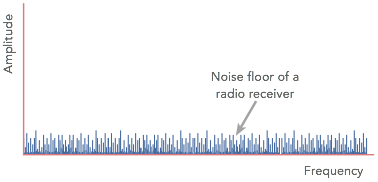What is Noise Floor for radio receivers
The noise floor of a radio receiver is the level of background noise that is present before any wanted signals are received.
Home » Radio & RF technology » this page
Radio Receiver Sensitivity Includes:
Receiver sensitivity basics
Signal to noise ratio
SINAD
Noise Figure, NF
Noise floor
Reciprocal mixing
The noise floor of a receiver is an important aspect of its operation as it gives a guide to the level of the minimum signal that can be received.
Noise is always present and received on a radio even when no wanted signals are present. The level of the noise floor determines the lowest strength signals that can be received and therefore the noise floor level is an important characteristic of any radio.
The noise floor can be defined as the measure of the signal created from the sum of all the noise sources and unwanted signals within a system.

When designing a radio receiver for any radio communications system it is necessary to ensure that the performance of the radio receiver matches the performance required. For some radio communications systems, typically those operating on frequencies below about 30 MHz, the level of noise from the antenna system may be relatively high. In these cases, it is of no use to have an ultra-low noise radio receiver. However in applications such as VHF and UHF fixed or mobile radio communications systems where the levels of received noise are much lower, then a low noise radio receiver is more useful.
Radio receiver blocks that affect noise floor
In order to reduce the levels of noise and thereby improve the sensitivity of the radio receiver, the main element of the receiver that requires its performance to be optimised is the RF amplifier.
The use of a low noise amplifier at the front end of the receiver will ensure that its performance will be maximised. Whether for use at microwaves or lower frequencies, this RF amplifier is the chief element in determining the performance of the whole receiver. The next most important element is the first mixer.
Radio receiver noise floor
While noise can emanate from many sources, when looking purely at the receiver, the noise is dependent upon a number of elements. The first is the minimum equivalent input noise for the receiver. This can be calculated from the following formula:
Where:
P is the power in watts
K is Boltzmann's constant (1.38 x 10^-23 J/K)
B is the bandwidth in Hertz
Using this formula it is possible to determine that the minimum equivalent input noise for a receiver at room temperature (290°K) is -174 dBm / Hz.
It is then possible to calculate the noise floor for the receiver at 20°C / 290°K in a 1Hz bandwidth:
Where:
NF is the noise figure
dBm is the power level expressed in decibels relative to one milliwatt
The concept of noise floor is valuable in many radio communications systems and enables the radio receiver design and performance to be matched to the requirements of the overall system.
 Written by Ian Poole .
Written by Ian Poole .
Experienced electronics engineer and author.
More Essential Radio Topics:
Radio Signals
Modulation types & techniques
Amplitude modulation
Frequency modulation
OFDM
RF mixing
Phase locked loops
Frequency synthesizers
Passive intermodulation
RF attenuators
RF filters
RF circulator
Radio receiver types
Superhet radio
Receiver selectivity
Receiver sensitivity
Receiver strong signal handling
Receiver dynamic range
Return to Radio topics menu . . .



